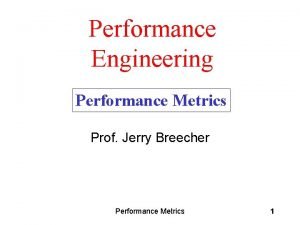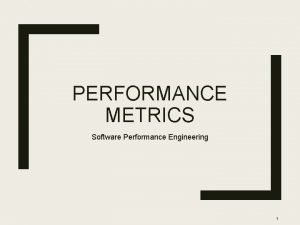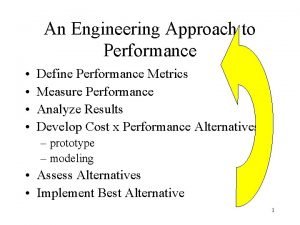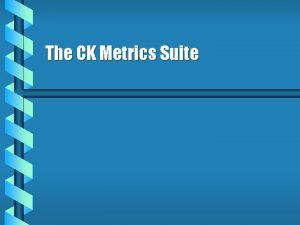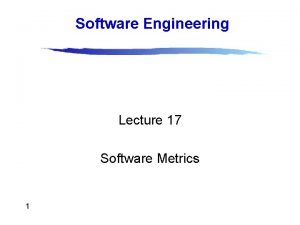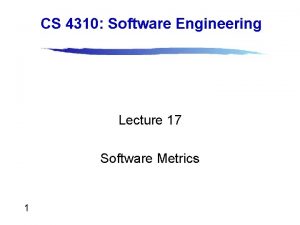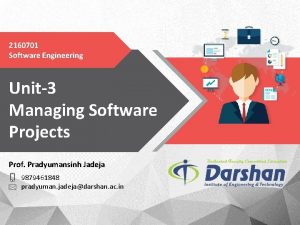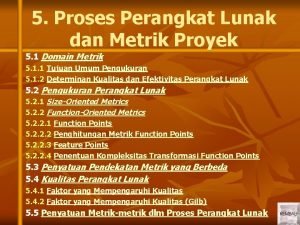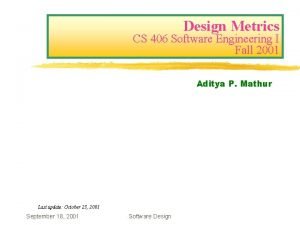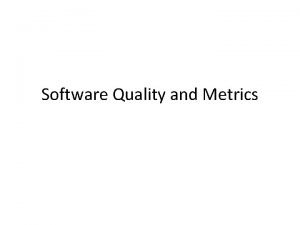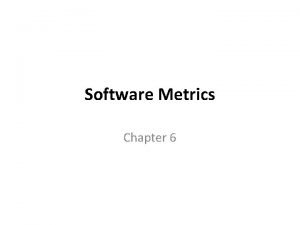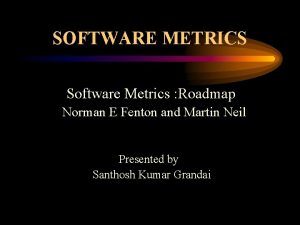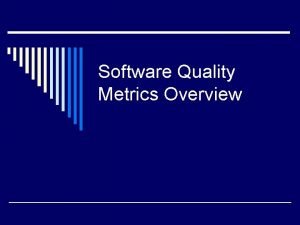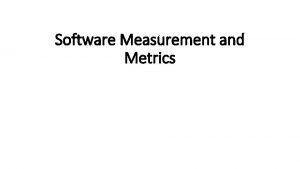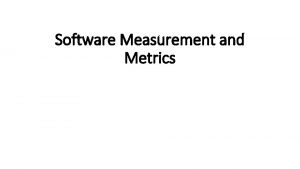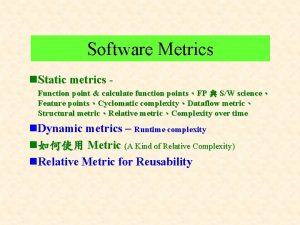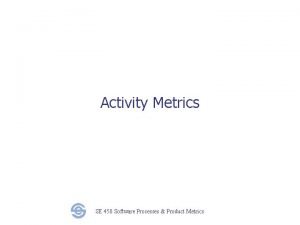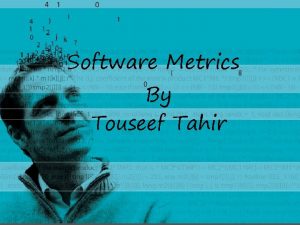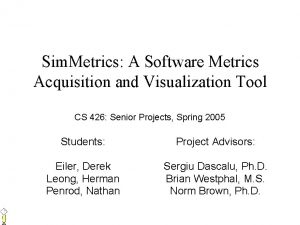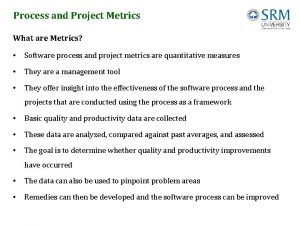PERFORMANCE METRICS Software Performance Engineering 1 How will
















- Slides: 16

PERFORMANCE METRICS Software Performance Engineering 1

How will you measure? ■ Metrics are a “standard of measurement” used to enforce your expectations – “Metric” is a method, e. g. your height – “Measurement” is a number or label, e. g. 5 ft 10 in ■ Defining your performance metrics is crucial – Clear requirements good tests – Clear requirements efficient development – Customer contracts ■ The earlier you can measure, the earlier you can inform decisions (esp. architectural decisions!) ■ Two types: – Resource metrics – User experience (UX) metrics 2

Common Metrics: UX ■ Response time – The total period of time between initiating a job and the job being completed – Can be defined at the system level, or subsystem level – Tends to be all-inclusive ■ ■ e. g. response time of a website includes network latency, server, application, database, etc. e. g. response time of a web server includes IO latency, communicating with other services, etc. ■ Service time – The time taken for a (sub)system to complete its task – Defined over a given “piece” of the system ■ Response time includes service time (and various other times) ■ Throughput – The rate at which the system completes a job 3

Common Metrics: Resource ■ Processor utilization – The percentage of time that the processor is used – This can be measured by application time, system time, user mode, privileged mode, kernel mode ■ Gets tricky when your system involves OS commands! – Typically measured by subtracting cycles from the “idle process” – Always defined over a period of time ■ Bandwidth utilization – Number of bits per second being transmitted divided by maximum bandwidth – Always defined over a period of time 4

Working with “Average” ■ For metrics based on transactions, compute arithmetic mean: – Sample statistic – e. g. “average response time over time [0, T]” where N(T) is the number of individual observations ■ For metrics based on time-averaging, use integral: ■ Multiprocessors: (p processors) 5

Common Metrics: Resource (2) ■ Device utilization – The percentage of time that any devices are being used ■ ■ e. g. disk utilization e. g. sensor devices like a gyroscope – Typically measured by sampling ■ Memory occupancy – The percentage of memory being used over time – Memory “footprint” is the maximum memory used – Measured in bytes – Can also be measured in malloc() calls and object instantiations 6

What Makes a Good Metric? ■ There are many, MANY properties of good metrics. ■ Here are some: – Linearity – Reliability – Repeatability – Ease of measurement – Consistency – Representation condition Source: Andrew Meneely, Ben H. Smith, Laurie Williams: Validating software metrics: A spectrum of philosophies. ACM Trans. Softw. Eng. Methodol. 21(4): 24: 124: 28 (2012) ■ Running example metrics – MIPS: millions of instructions per second to measure processor speed – SLOC: number of lines of source code 7

Linearity & Reliability ■ Linearity – Our notion of performance tends to be linear, and so should our metrics – Many of our future analyses of queuing theory assume linearity of metrics ■ – e. g. “the average response time decreased by 50%” should mean that the response time is actually half Metrics that are NOT linear ■ ■ Decibels – logarithmic Richter scale for earthquakes – logarithmic ■ Reliability – System A can outperform System B whenever the metric indicates that it does – Execution time is fairly reliable, but MIPS is not (memory not included) 8

Repeatability & Ease of Measurement ■ Repeatability – If we run the experiment multiple times under the same conditions, do we get the same results? – SLOC is repeatable – Execution time is repeatable, but the conditions can be tough to replicate every time ■ Ease of measurement – Is the procedure for collecting this metric feasible? – Do we require too much sampling? Does the sampling interfere with the rest of the system? 9

Consistency ■ Consistency – Is the metric the same across all systems? – MIPS is not consistent across architectures: CISC and RISC – SLOC is not consistent across languages, e. g. Ruby SLOC versus C SLOC 10

Representation Condition ■ Your empirical measurements should represent your theoretical model – “Under the Representation Condition, any property of the number system must appropriately map to a property of the attribute being measured (and vice versa) – Linearity is an example of applying the representation condition to scale – i. e. Mathematical transformations on the empirical data should align with – e. g. SLOC fails RC for functional size because poorlywritten code can be large in SLOC but functionally small 11

Key Metric Lessons ■ One metric does not tell the whole story – You will always need multiple – Performance is a multi-dimensional concept ■ A performance requirements must define context – What metrics? – Under what load conditions? – Over what period of time? 12

Practice: Parcel Processing ■ Package processing plant ■ System of conveyor belts ■ Parcels get scanned Induct DB Bar ■ Programming logic code controllers (PLC) determine where everything goes PLC – Communicate with each other – DB provides broad PLC directions ■ What are some metrics we can monitor? PLC Conveyor 13

Metrics for Parcel Processing ■ # parcels per second at each point on the conveyor ■ Speed of the conveyor ■ Distance between parcels ■ Average length of a parcel ■ Query rate of parcel routing database ■ Response time to parcel routing database ■ Latencies between PLCs ■ PLC service time 14

Practice: Global Village ■ Let’s model as a class the Global Village cafeteria 15

More practice ideas ■ Bar at a theater during intermission ■ Fire alarm control panel 16
 Metrics computer science
Metrics computer science Examples of product metrics
Examples of product metrics Engineering performance metrics
Engineering performance metrics Software performance metrics
Software performance metrics Engineering performance metrics
Engineering performance metrics Ck metrics in software engineering
Ck metrics in software engineering Data structure metrics in software engineering
Data structure metrics in software engineering Process and project metrics in software engineering
Process and project metrics in software engineering Function point metrics in software engineering
Function point metrics in software engineering Basic software engineering
Basic software engineering Project metrics in software engineering
Project metrics in software engineering Process metrics in software engineering
Process metrics in software engineering Design metrics in software engineering
Design metrics in software engineering Quality metrics in software engineering
Quality metrics in software engineering Computer based system engineering in software engineering
Computer based system engineering in software engineering Forward engineering in software engineering
Forward engineering in software engineering Intranet performance metrics
Intranet performance metrics


